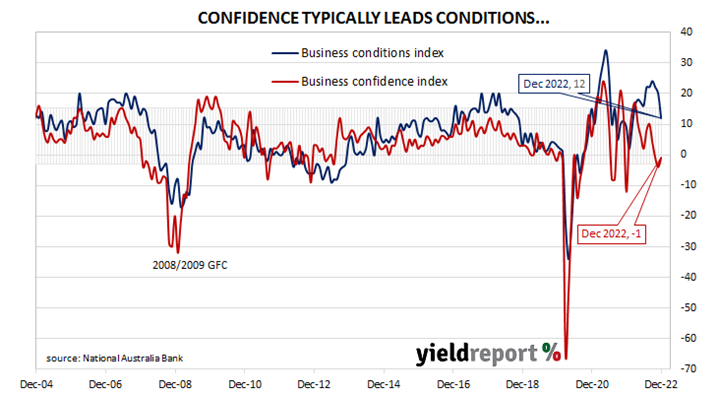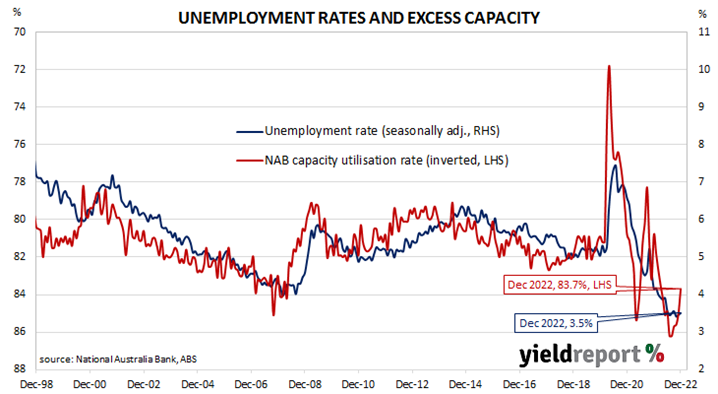Summary: Business conditions deteriorate in December; confidence improves but still negative; confidence index up but still below zero; healthy level of current activity but with slowing momentum; ANZ: “tide is turning”; capacity utilisation rate declines but still elevated.
NAB’s business survey indicated Australian business conditions were robust in the first half of 2018, with a cyclical-peak reached in April of that year. Readings from NAB’s index then began to slip and forecasts of a slowdown in the domestic economy began to emerge in the first half of 2019 as the index trended lower. It hit a nadir in April 2020 as pandemic restrictions were introduced but then conditions improved markedly over the next twelve months. Subsequent readings were generally in a historically-normal range until the second half of 2022.
According to NAB’s latest monthly business survey of over 400 firms conducted in first full week of January, business conditions have deteriorated for a third consecutive month. NAB’s conditions index registered 12 points, down 8 points from November’s reading.
In contrast, business confidence improved, albeit to a level which is still negative. NAB’s confidence index increased from November’s reading of -4 points to -1 point, 7 points below the long-term average. Typically, NAB’s confidence index leads the conditions index by one month, although some divergences have appeared from time to time.
“Overall, the survey continues to point to a healthy level of activity with above average conditions and elevated capacity utilisation,” said NAB senior economist Brodey Viney. However, he also pointed to “a slowing in momentum with most indicators pulling back over the past three months or so…”
Commonwealth Government bond yields moved a touch higher on the day. By the close of business, 3-year and 10-year ACGB yields had both inched 1bp higher to 3.06% and 3.47% respectively while the 20-year yield finished unchanged at 3.87%.
In the cash futures market, expectations regarding future rate rises over the next few months softened. At the end of the day, contracts implied the cash rate would rise from the current rate of 3.07% to average 3.20% in February and then increase to an average of 3.47% in May. August contracts implied a 3.57% average cash while November contracts implied 3.55%.
“The tide is turning in NAB’s December Business Survey, with business conditions dropping 8 points and forward orders coming off, albeit from high bases,” said ANZ economist Madeline Dunk. However, she did note “inflationary pressures are subsiding.”
NAB’s measure of national capacity utilisation remained at a historically-elevated level although it declined from November’s revised figure of 85.0% to 83.7%. All eight sectors of the economy were reported to be operating at or above their respective long-run averages.
Capacity utilisation is generally accepted as an indicator of future investment expenditure and it also has a strong inverse relationship with the unemployment rate.



